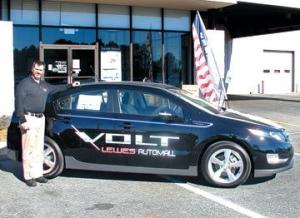Chevy Volt moves the electric car to a new level of efficiency
Electric cars aren’t new. Between 1832 and 1839, the first crude electric carriages were in use in Europe. Over the course of nearly 180 years, electric car technology inched ahead.
In 1996, General Motors (GM), founded in 1908 and known for mass-producing cars with internal combustion engines, rolled out its EV1.
The car was GMs’ first mass-produced electric vehicle and was available for lease only. In 2002, after leasing fewer than 1,000 cars, the company discontinued the program.
Jump ahead about 15 years after the EV1’s introduction, and GM is back with another electric car: its 2011 Chevy Volt.
Available locally
John “JB” Barbarulo, new car salesman for Lewes AutoMall, said dealership owner Chris Dagesse bought two Volts. “He purchased the cars from regular retail sellers so that we’d have an opportunity to show the new technology to people in Delaware,” Barbarulo said.
Initially, General Motors is only making the cars available to dealers in Texas, New York City, New Jersey, Connecticut, California, Michigan and Washington, D.C. One car has been in Lewes, and the other is at affiliated dealership NuCar Auto Group in New Castle County for about a month. Barbarulo said since their arrivals, many people have visited the dealerships anxious to see the cars and check out the technology.
He said in mid-February, GM announced the car should be available at Chevy dealerships in all 50 states by the end of this year. The car isn’t being sold as a special order vehicle, but Barbarulo said dealers would be taking presold orders. “We’ll probably have orders that will be more than they’ll be building,” he predicted.
Electric and gasoline
“The vehicle has a 9-gallon fuel tank, which will give you 300 miles,” he said. GM estimates it costs about $1.50 a day to charge the car’s batteries. He said development of commercial recharging stations is just beginning in major metropolitan areas. “But with the Volt, you really don’t have to worry about that. If you run out of charge, it’s just going to go to the gasoline generator. You’re never going to get stuck with the vehicle. That’s the nice thing about the Volt,” Barbarulo said.
The vehicle is classified as an electric car with a gasoline generator. “It’s not considered a hybrid, although it does have some hybrid characteristics as far as using a gasoline engine,” Barbarulo said.
Because low temperatures quickly drain battery energy, the Volt automatically switches the generator on to maximize efficiency.
Even when the car’s battery is fully charged, the gasoline generator will still activate when temperatures are extremely cold.
Barbarulo said those who routinely use the car for short distances should find they have to recharge the battery only twice a week. He said they should also rarely have to buy gasoline. “The generator is going to come on periodically just to keep everything lubricated properly,” he said.
Barbarulo said when he drove the car for a weekend, he was getting the equivalent of 200 miles per gallon, because it was constantly running in electric mode. “You get the feel of the vehicle once you read the owner’s manual and start driving it,” he said. He said the owner’s manual recommends leaving the car plugged in during cold weather when it isn’t in use. “It’s not drawing much electricity and it keeps the battery at peak efficiency,” he said.
Volt is groundbreaking
Barbarulo said defining the Volt’s technology as the greatest change in automotive history would be an overstatement. “But it is huge. Here’s a vehicle that all week long doesn’t put any pollutants into the air. “Yes, it takes power to charge the batteries, and there are all kinds of arguments saying green cars aren’t as green as you think they are. “But this is breakthrough technology. We produce electricity with coal, which we have an abundance of, vs. gasoline, which we don’t have an abundance of,” he said.
Volt sticker
Barbarulo said because the car uses some new technologies, it costs somewhat more than similarly sized cars. “Depending on how it’s equipped, the car has a sticker price from around $32,000 to $42,000. Right now the government is offering a $7,500 incentive for buying the vehicle,” Barbarulo said.
Like most new technology, however, he said the Volt’s sticker price would come down as its popularity grows.
About the Chevy Volt
The Volt combines several technologies making it the first vehicle of its kind.
Most of the car’s features are standard, such as dual-stage airbags: frontal, side-impact and knee for driver and front passenger; and roof-rail, side-impact for front and rear outboard seating; StabiliTrak with traction control; tire pressure monitor; and lithium-ion batteries.
• The Volt’s batteries recharge overnight using a standard, 110-volt line/socket; the battery recharges more efficiently - in three to four hours - using a 240-volt line/socket
• A General Motors four-cylinder engine powers only the generator; the generator only keeps the battery charged, the battery-powered electric motor turns the wheels, and the car uses a one-speed, continuously variable electric transmission
• The Volt has a regenerative braking system, so when the brakes are used, energy created is converted into electricity, which is sent to the batteries. When drivers take their feet off the accelerator and the car is coasting, that energy is also sent to the batteries. This allows the car to create and store electricity in heavy stop-and-go traffic
• The car comes with a 100,000 mile/five-year, transferable, powertrain limited warranty with no deductible














































